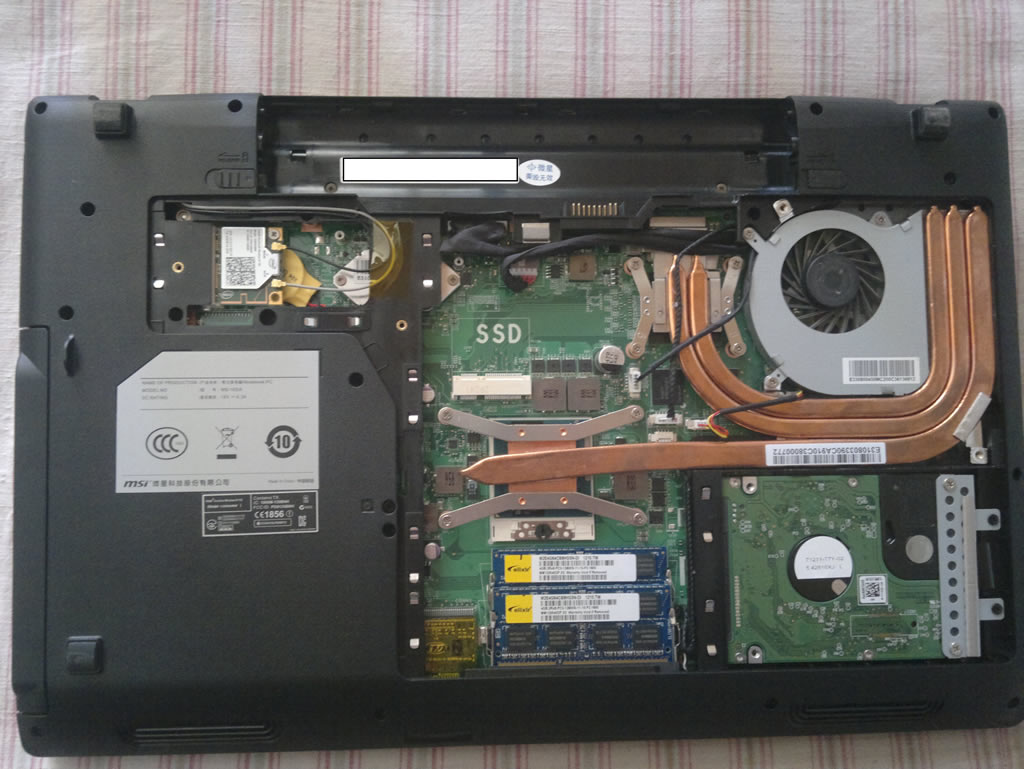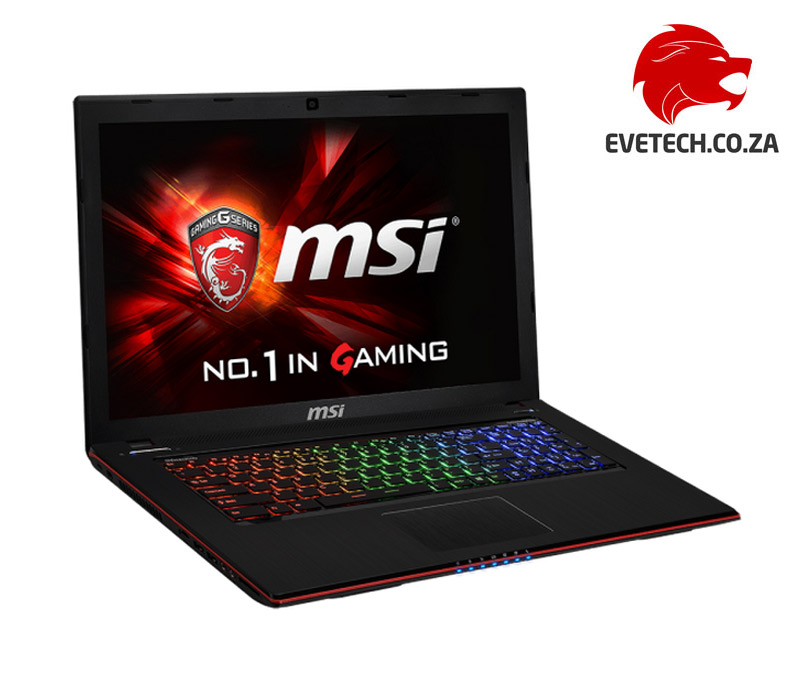Msi Ge60 Ssd Slot

Msi Ge60 0nd Ssd Slot
Quick Navigation:
After that I couldn't see the SSD during the installation menu. I can see the SSD in the BIOS menu, but when it comes to win installation I can't see it. I tried the 'irstintel f612.8.2.10000xbb1e7aacw8100' diver which MSI suggested during WIN 10 installation. It looked as if it is installed, but nothing changed. SSD mSATA en GE60-480xes/637xes Productos. Tengo un problema con mi nuevo msi ge60 2pe apache pro resulta que cuando enciendes el ordenador se deverian.
Hard Drive or SSD Specifications Check
If you want to upgrade your hard drive for your MSI gaming laptop for better performance, you may need to consult your manufacturer for the detailed specifications first.
As far as I know, apart from GS series, GT, GE, GP, GL, GF series, like MSI GT76/63, GE65, GP75, GL65/75, GF63, they have one of the three hard drive (or SSD) settings:
One M.2 SSD slot, two M.2 SSD combo slot and one 2.5” SATA HDD.
One M.2 SSD combo slot and one 2.5” SATA HDD.
Only one 2.5” SATA HDD.

If your MSI laptop belongs to GS series, like GS65, GS75, you’re not allowed to unauthorized disassembly for hard drive. Otherwise, the warranty period is deemed to have expired. It’s better to go to MSI Service Center for MSI hard drive upgrade.
Generally speaking, MSI gaming laptops come with a 1T HDD drive usually, and some of them pre-installed a small 120GB or bigger SSD. So, how to upgrade hard drive for better performance if there is no enough space? Perform MSI laptop hard drive replacement or doing MSI laptop SSD upgrade may be the ideal solution at this moment.
How to Do MSI Hard Drive Upgrade?
Maybe you have other solutions to do this upgrade, like buy a bigger HDD or SSD, then replace your original one with the new one, then reinstall your Windows 7/8/10 with the Windows installation media. However, this way will take up a lot of time and is quite complicated.
To make it easy for you to perform MSI laptop hard drive replacement, it’s highly recommended to try the best disk cloning software - AOMEI Backupper Professional. AOMEI Backupper offers two solutions for your MSI hard drive replacement in Windows 10/8.1/8/7/Vista/XP:
Backup hard drive to USB/external drive then restore to SSD drive.
Please download the AOMEI Backupper Professional 30-day free trial and have a try: (The Clone features in the free trial can only be demonstrated, please upgrade to enjoy.)
Download Free Trial
Win 10/8.1/8/7/XP
Secure Download
What Do You Need?
Before you do, please prepare the following things.
Your MSI laptop with Windows installed.
A brand new SSD. To make sure what kind of SSD suitable for your MSI computer, consult for the manufacturer.
A USB flash drive or external hard drive.
SATA to USB enclosure or M.2 to USB enclosure.
Screwdriver.
Create a WinPE bootable media with AOMEI Backupper.
Way 1. MSI laptop SSD upgrade with clone feature
Here is how to upgrade MSI hard drive with the SSD using the Disk Clone feature in just a few clicks:
1. Use the SATA to USB enclosure or M.2 to USB enclosure to connect the new SSD, or you can just install the new SSD into the computer. Ensure the SSD can be detected by Windows.
2. Launch AOMEI Backupper Professional, select Disk Clone under Clone tab.
3. Choose the MSI hard drive as the source disk, and press Next.
4. Select the new SSD as the destination disk, and hit Next.
5. Tick SSD Alignment to speed up the SSD and press Start Clone >> to upgrade hard drive to SSD for MSI laptop in Windows 10/8/7.
★ Tips:
✍ Edit Partitions will help you fully use the storage space on the destination disk while cloning disk to larger disk.
✍ Sector by Sector Clone enables you clone all sectors on the source disk, and the time will be much longer. Uncheck this option only clone the used sectors which makes the clone be quicker.
After the clone finished, please restart your computer to boot into BIOS, and then change the boot order to boot from the cloned SSD; or shut down the computer, and replace the hard drive with the SSD, and boot the computer from it.
Way 2. Replace hard drive for MSI with backup & restore
All detailed steps listed below to upgrade MSI hard drive to SSD with Backup and Restore features.
Step 1: Backup MSI Original Hard Drive
1. Connect the USB drive or external hard drive with your MSI laptop, launch AOMEI Backupper, select Backup -> Disk Backup in turn.
2. Click + Add Disk, tap to select the MSI hard drive and click Add. Modify the Task Name to differ from others if required.
★Tip: If you want to backup more than one disk, you can repeat step 2.
3. Select the external hard disk or USB flash drive as destination path and click Start Backup.
There are some optional settings you could customize before backing up MSI hard drive:
✍Options allows you to comment, compress, split, even encrypt the disk backup task, use VSS, make an exact copy(sector by sector backup), enable email or SMS notification, etc.
✍Schedule offers 5 modes for you to automatically backup hard drive, daily, weekly, monthly, event triggers, USB plug in. Besides, you could create full backup, or incremental and differential backup, etc.
✍The Scheme option could help you automatically delete old backup images once the backups over the number you specified to free up space.
After the backup finished, the disk image file of MSI hard drive has been stored to the USB drive or external hard drive.

Step 2: Remove MSI original hard drive and connect SSD
On this condition, shut down your laptop, and upside down.
Unscrew the screws that keep the back cover in place. Gentally pull off the back cover.
Unscrew the screw for fixing the battery, and take it out carefully from the MSI laptop.
Gentally pull the MSI hard drive out after unscrewing the screws on the hard drive.
Put the new SSD drive into the slot.
Step 3: Restore MSI Disk Image to SSD drive
1. Plug the USB flash drive or external hard drive into the MSI laptop, boot your computer from the WinPE bootable media created before, and AOMEI Backupper will automatically run on your computer. Click Restore, and Select Task or Select Image File to locate the MSI disk image.
2. Select to Restore the entire disk or Restore a partition in the disk and click Next >>.
3. Choose the new SSD drive as destination to restore entire disk, and then press Next >>.
★Tips: If your destination disk is different from your backup source disk, you will be prompted by this message 'Because your current selected destination hard disk is different from the backup source hard disk, please make sure that your system is Windows Vista or latter Windows 64-bit OS. Otherwise, it may cause destination system boot failure after restoring.'
4. Preview the result of restoring, and check the SSD Alignment option to optimize reading and writing speed for SSD, press Start Restore >>.
★ Tip: The Universal Restore could help you to restore disk image to another computer even with different hardware configuration. And make it bootable without any issues.
Until now, the MSI SSD upgrade has been done successfully. Just enjoy it.
Msi Ge60 Ssd Slot Drivers
Further Reading: MSI RAM (Memory) Upgrade
Besides, you could upgrade your memory (RAM) to get better performance, MSI gaming laptops allow you to upgrade RAM up to 64GB. Generally, you have RAM 16GB (8GB*2) with 2 slots. If you want to upgrade RAM to 32GB or 64GB, buy compatible larger RAM sticks, and then replace them with the new RAM sticks.
How to upgrade RAM for MSI computers, refer to the following:
Shut down MSI gaming computers, and upside down.
Pull off the back cover after taking out the screws.
Release the buckle and take out the two old smaller RAM sticks.
Insert larger RAM sticks at an angle of 45° and press it down to secure it tightly by the buckle.
Put everything to its places, and MSI RAM upgrade is done.
Conclusion
With this powerful Windows backup software - AOMEI Backupper, MSI hard drive upgrade has been finished with a success. AOMEI Backupper also provides system clone for cloning Windows operating system only, and allows you to create bootable media to restore windows when your MSI laptop refuses to boot.
If you want to protect unlimited computers within your company, you can pick AOMEI Backupper Technician. With the inbuilt AOMEI Image Deploy tool, you are also allowed to deploy/restore system image file on server-side computer to multiple client-side computers over network.
For who is running Windows Server 2003, 2008, 2012, 2016, 2019 (including R2), please try AOMEI Backupper Server to enjoy more advanced features, like universal restore, command line utility to backup/restore/clone, create differential backup with a schedule task, etc.
March 20th, 2020, 10:49
I have MSI GE60 PC Apache laptop. The computer came with originally installed TOSHIBA THNSNJ128GMCU SSD. It has the operating system installed already. Everything was fine with the laptop, but the disks were garbage. So I want to format the both SSD and the other HD.(BIOS UEFI function is enabled, also UEFI CSM mode tried, both secured boot option disabled) Before I did the formating I erased the partitions of both the SSD and the HD with the win 10(Microsoft clean installation one) installation menu. After that I couldn't see the SSD during the installation menu. I can see the SSD in the BIOS menu, but when it comes to win installation I can't see it. I tried the 'irst_intel f6_12.8.2.1000_0xbb1e7aac_w8100' diver which MSI suggested during WIN 10 installation. It looked as if it is installed, but nothing changed. Also when I install the win to the HD I see the SSD in the 'disk management' part of the Windows and in the device manager, but nowhere else. I reinstalled the SSD. I opened the back cover take the SSD out and then put it back. That didn’t work. I take the HD out and try to format the SSD by this way, it didn’t work either. MSI international help service couldn’t solve the problem either. Their final solution was asking me to send the machine to a local technical service. I know that they will not find a solution either. The only thing I didn’t try is finding a M2 slot machine, format my SSD with it then reinstall it to my laptop. Unfortunately I couldn’t find a laptop with M2 slot in the area where I live. That is the whole story, do you have any other solutions for he problem. Thanks in advance.
- Attachments